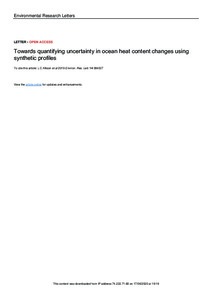| dc.contributor.author | Allison, L.C. | |
| dc.contributor.author | Roberts, C.D. | |
| dc.contributor.author | Palmer, M.D. | |
| dc.contributor.author | Hermanson, L, | |
| dc.contributor.author | Killick, R.E. | |
| dc.contributor.author | Rayner, N.A. | |
| dc.contributor.author | Smith, D.M. | |
| dc.contributor.author | Andrews, M.B. | |
| dc.date.accessioned | 2020-06-17T18:54:45Z | |
| dc.date.available | 2020-06-17T18:54:45Z | |
| dc.date.issued | 2019 | |
| dc.identifier.citation | Allison,L.C., et al (2019) Towards quantifying uncertainty in ocean heat content changes using
synthetic profiles. Environmental Research Letters, 14: 084037, 13pp. DOI: https://doi.org/10.1088/1748-9326/ab2b0b | en_US |
| dc.identifier.uri | http://hdl.handle.net/11329/1359 | |
| dc.identifier.uri | http://dx.doi.org/10.25607/OBP-865 | |
| dc.description.abstract | Observational estimates of global ocean heat content (OHC) change are used to assess
Earth’s energy imbalance over the 20th Century.However, intercomparison studies show that the
mappingmethods used to interpolate sparse ocean temperature profile data are a key source of
uncertainty. We present a new approach to assessing OHC mapping methods using ‘synthetic profiles’
generated froma state-of-the-art global climate model simulation. Synthetic profiles have the same
sampling characteristics as the historical ocean temperature profile data but are based on model
simulation data.Mapping methods ingest these data in the same way as they would real
observations, but the resultant mapped fields can be compared to a model simulation ‘truth’. We
use this approach to assess two mapping methods that are used routinely for climate monitoring
and initialisation of decadal forecasts. The introduction of the Argo network of autonomous
profiling floats during the 2000s drives clear improvements in the ability of these methods to
reconstruct the variability and spatial structure ofOHCchanges. At depths below 2000 m, both
methods underestimate the magnitude of the simulated ocean warming signal. Temporal
variability and trends in OHC are better captured in the better-observed northern hemisphere than
in the southern hemisphere. At all depths, the sampling characteristics of the historical data
introduces some spurious variability in the estimates of global OHC on sub-annual to multiannual
timescales.However,many of the large scale spatial anomalies, especially in the upper
ocean, are successfully reconstructed even with sparse observations from the 1960s, demonstrating
the potential to construct historical ocean analyses for assessing decadal predictions. The value of
using accurate global covariances for data-poor periods is clearly seen. The results of this
‘proof-of-concept’ study are encouraging for gaining further insights into the capabilities and
limitations of different mappingmethods and for quantifying uncertainty in global OHC
estimates. | en_US |
| dc.language.iso | en | en_US |
| dc.rights | Attribution 3.0 | * |
| dc.rights.uri | http://creativecommons.org/licenses/by/3.0/ | * |
| dc.subject.other | Ocean heat content | en_US |
| dc.subject.other | Uncertainty | en_US |
| dc.subject.other | Synthetic profiles | en_US |
| dc.title | Towards quantifying uncertainty in ocean heat content changes using synthetic profiles. | en_US |
| dc.type | Journal Contribution | en_US |
| dc.description.refereed | Refereed | en_US |
| dc.format.pagerange | 13pp. | en_US |
| dc.identifier.doi | 10.1088/1748-9326/ab2b0b | |
| dc.subject.parameterDiscipline | Parameter Discipline::Physical oceanography::Other physical oceanographic measurements | en_US |
| dc.bibliographicCitation.title | Environmental Research Letters | en_US |
| dc.bibliographicCitation.volume | 14 | en_US |
| dc.bibliographicCitation.issue | Article 084037 | |
| dc.description.sdg | 14.A | en_US |
| dc.description.eov | Ocean surface heat flux | en_US |
| dc.description.maturitylevel | TRL 7 System prototyping demonstration in an operational environment (ground or space) | en_US |
| dc.description.bptype | Manual (incl. handbook, guide, cookbook etc) | en_US |
| obps.contact.contactname | Lesley Allison | |
| obps.contact.contactemail | lesley.allison@metoffice.gov.uk | |
| obps.resourceurl.publisher | https://iopscience.iop.org/article/10.1088/1748-9326/ab2b0b | en_US |
 Repository of community practices in Ocean Research, Applications and Data/Information Management
Repository of community practices in Ocean Research, Applications and Data/Information Management

